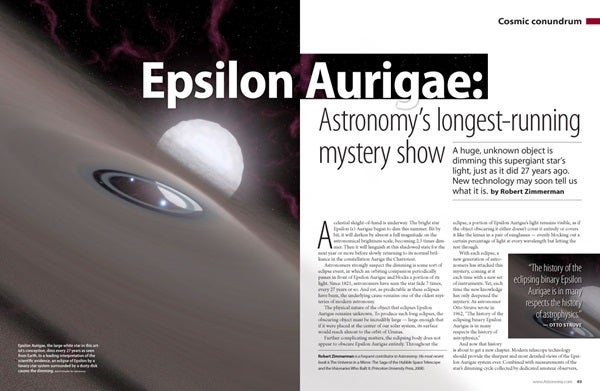This fall, a bright star will begin a puzzling transformation that only happens every 27 years. To help study this event, astronomers have launched a new citizen science project called “Citizen Sky” at www.CitizenSky.org.
Epsilon Aurigae is a bright star that can be seen with the unaided eye even in bright urban areas of the Northern Hemisphere from fall to spring. This fall, it is predicted to gradually lose half its brightness until early winter. It will remain faint during all of 2010 before slowly regaining its normal brightness by the summer of 2011.
Since its discovery in 1821, the cause of this dip in brightness has remained a mystery to astronomers. But this time they have a powerful new resource to help study the upcoming event: thousands of citizen scientists.
“This star is too bright to be observed with the vast majority of professional telescopes, so this is another area where public help is needed,” said Arne Henden, director of the American Association of Variable Star Observers (AAVSO).
Supported by a 3-year grant from the National Science Foundation, Citizen Sky will recruit, train, and coordinate public participation in this project. What makes this project different from previous citizen science projects is its emphasis on participation in the full scientific method. Participants are not being asked simply to collect data. They also will be trained to analyze data, create and test their own hypotheses, and write papers for publication in professional astronomy journals. Participants can work alone on all phases of the project, or they can focus on one stage and team up with others.
“Citizen science can be much more than data collection,” Henden said. “Participants often have real-world experience and/or advanced degrees in areas that can be applied to astronomy. Our goal is to introduce the public to authentic science and at the same time use this talent to help astronomers.”
The lead astronomer for this project is Robert Stencel, the William Herschel Womble Professor of Astronomy at Denver University. Dr. Bob, as the amateur astronomy community knows him, studied the last event in 1982-84 while working at NASA.
“This is truly an amazing star system,” Stencel said. “It contains both a supergiant star and a mysterious companion. If the supergiant was in our solar system, its diameter would extend to Earth, engulfing us. The companion only makes its presence known every 27 years and is a type of ‘dark matter’ in that we indirectly detect its presence but don’t know what it is.
“To make things even more fun, we also have some evidence of a substantial mass, perhaps a large planet, spiraling into the mysterious dark companion object,” Stencel added. “Observations during the upcoming eclipse will be key to understanding this and predicting what will happen if the putative planet does eventually fall into the star.”
To learn more about the Epsilon Aurigae’s mysterious history and current theoretical models of the system, check out the October issue of Astronomy magazine, on newsstands September 1. You can also discuss your observations on our Reader Forums.










